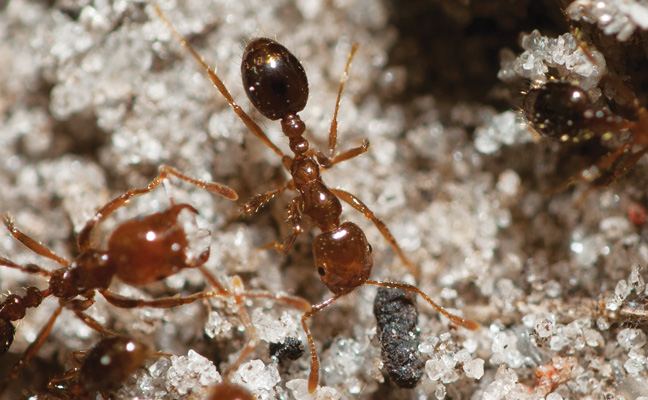
Photo courtesy of, and copyrighted by, Gene White, pmimages@earthlink.net
Solenopsis invicta
Alias: Red imported fire ants
Description
- Solenopsis spp. fire ants are capable of inflicting stings that can be serious; the venom they inject causes a burning sensation, which is how they got their name.
- In the United States, four Solenopsis fire ant species can be found: red imported fire ant (RIFA, S. invicta), black imported fire ant (S. richteri), southern fire ant (S. xyloni), and tropical fire ant (S. geminata). Of these, most problematic encounters involve RIFA and black imported fire ants.
- RIFA polymorphic workers are dark reddish-brown. Their size varies from 1/15 to 1/4 of an inch in length.
- They have either one reproductively active queen per colony, which is known as a monogynous colony, or many reproductively active queens, which is known as a polygynous colony.
- Control may be more difficult in areas with multiple-queen colonies.
- The home range of large, polygynous colonies may be difficult to determine, and the range of individual colonies can overlap.
- Large colonies can have up to 500,000 workers that forage over an area with a radius of more than 100 yards.
Life Cycle
- Average-size yards may contain several mounds, whereas larger yards may contain several dozen mounds.
- Each mound may be inhabited by a separate colony, which typically will be a monogynous colony, or one colony may occupy several distinct mounds that are connected by underground foraging tunnels.
- Occasionally, the ants will nest under bathtubs (the slab under the tub often offers access to soil), next to water heaters or near other sources of warmth inside homes or buildings such as hospitals or nursing homes, especially in the winter.
Behavior
- Nests, with their characteristic earth mounds, are mostly found in soil. However, they can occasionally be found indoors — in undisturbed piles of dirty laundry, for example.
- When their earth mounds are disturbed, the workers appear to boil, or swarm, out of the ground in an aggressive defensive behavior. They will repeatedly sting any animal they consider to be an intruder.
- They often can be found where people congregate, such as lawns, parks, cemeteries and ballfields. Their aggressive stinging behavior becomes intolerable in most situations.
Food
- RIFA are both predators and scavengers. They may attack and kill other insects and small animals, or feed on dead animals.
- They also feed on sweets, such as honeydew, certain parts of plants, and plant secretions.
Range
➔ In the United States, RIFA can be found in the Coastal Plain areas of the southern states, from South Carolina along the Atlantic Coast into northern and central Florida, across the southern states and into much of the eastern half of Texas. They also are established in the urban and coastal areas of Southern California, and outbreaks occur in some of the desert cities between West Texas and Southern California.
➔ Distribution in northern areas is limited by the severity of winter conditions; they are not found where moderate to hard frosts are common during winter.
Prevention
➔ Seal entry points into structures.
SOURCES:
Truman’s Scientific Guide to Pest Management Operations
USDA Cooperative Extension
Leave A Comment